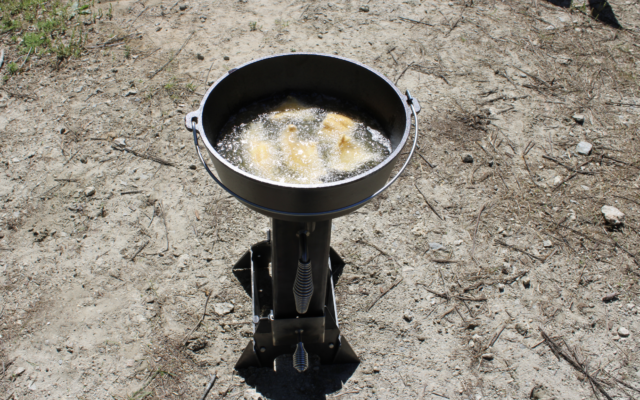by Kelly Reeves
We all know that Hank Hill loves propane and propane accessories. In fact, I love propane, too. Gas grills, fish fryers, and portable heaters all work well when fueled by propane but, in recent years the Rocket Stove has become a major topic of discussion in the outdoor world. Campers, preppers, homesteaders, hunters, and others have grown fond of the idea of having the ability to easily and efficiently fuel a heat source and have an easily mobile cooking platform that requires no gas or electricity.
The only necessity is a very small amount of sticks and a flame to have a reliable heat source. The price of propane is almost $3 per gallon. Fuel for a rocket stove is free and the supply is endless. A handful of sticks the size of a #2 pencil and a little bigger will allow you to cook a meal or boil a pot of water in short order.
The rocket stove is a small L-shaped steel stove that uses small sticks or wood scraps as fuel. It is designed to function at very high temperatures and produce virtually no combustion smoke. The design allows for air to be sucked in from below the fire. As the fire heats up, it draws more air and the result is a roaring sound from the air flow, much like a rocket. Hence, the name … rocket stove.
Being vaguely familiar with rocket stoves, but having no actual experience with them, I turned to YouTube for my initial research. I watched a few videos and began planning my first experience with a rocket stove. I borrowed a light weight portable rocket stove from a friend who had bought, but never used it. It was made of sheet metal and weighed less than eight pounds. I assembled the stove and placed some pine straw and a handful of small dry sticks into the fuel chamber and lit it. I soon had a steady fire burning. I set a 12” cast iron pot on the cooking surface and poured a gallon of water in the pot. Although the rocket stove was sitting level and plumb atop a concrete surface, it was very unstable due to the light weight material it was made from. The entire stove was shaky and unsafe, and I could envision the stove turning over with ease. I removed the pot, closed the damper, and allowed the fire to burn out. I felt like the poor quality of this particular stove made it too dangerous to experiment with.
Back to the drawing board.
I made a few calls and did a little more YouTube research and learned about a couple, Jason and Miranda Chiasson (pronounced Sha-sone), who are known to produce high quality rocket stoves in their welding shop known as Chiasson Smoke in Blue River, Wisconsin. Hold on a second … Jason is not a Yankee. He was transplanted in Wisconsin after being born and raised in South Louisiana! His cajun roots run deep as evidenced by his French Cajun name and the true cajun recipes he often shares on his Chiasson Smoke YouTube and IG channels. I called Jason and was able to pick his brain about rocket stoves in general, and his product. A few days later I found myself unpacking and assembling a Chiasson Smoke Rocket Stove. The differences in this stove and my first one were immediately evident. This stove weighs about 30 pounds verses the other at under 8 pounds. At 30 pounds it is heavy enough to be very sturdy, but light enough to be easily portable. It was simple to assemble and disassemble, and fits perfect in a small plastic tote for transportation.
Round Two
I assembled the new rocket stove from Chiasson Smoke. I gathered some tinder and a handful of small sticks and lit a fire in the chamber with the damper open. In about six minutes I had a roaring fire going and very high heat at the cooking surface. Initially, there was some smoke coming from the stove but, I noticed that as the heat increased, the smoke decreased to almost no smoke at all. I was burning oak and pecan sticks as that is what was handy. I added a few sticks to the chamber and again set my 12” cast iron pot atop the cooking surface and poured a gallon of water into it. This stove was very sturdy and stable. It took 12 minutes to have the gallon of water at a rolling boil. This part of my experiment went better than I expected.
Next, I emptied the water and returned my pot atop the rocket stove. I closed the damper to decrease the heat at the cooking surface. I added peanut oil to the pot and allowed it to heat while I prepared some channel catfish filets for frying. I quickly had the oil temperature to 300 degrees but had to open the damper slightly to allow air into the stove to increase the heat to 350. I found regulating the heat was quite easy and it only took a very short time to get to frying temperature. I was able to fry three batches of filets, two batches of potatoes, and a few hush puppies in short order without any trouble at all. The rocket stove worked perfectly and was very stable during use. I added sticks to the rocket stove twice during the entire cook.
A few days later, I again lit the rocket stove and cooked a pot of chicken and sausage gumbo. From boiling the chicken, to making my roux, adding all the meats and vegetables, and allowing it to simmer for an extended period of time, the rocket stove worked flawlessly. I found it very simple to control the heat using the damper and amount of fuel burning. I expected to have more difficulty controlling the temperature but it was not an issue, at all.
My Conclusion
The rocket stove is probably not for everyone, but it is for me. I found the transporting and assembly very easy for campers, or others in remote locations. I really liked not having to fill, haul and handle a propane bottle for cooking. The ability to scavenge a small amount of sticks for all your cooking needs is a huge plus for the rocket stove. The rocket stove design allows only the lower end of your fuel (sticks) to burn, then allows the sticks to slide down the fuel chamber and feed itself as it burns. This design allows for a small amount of sticks to cook for a longer time period. To be fair, as easy as I found the rocket stove to cook on, it is not as quick as turning on a propane burner and lighting it. It does take a few minutes for the fire to get going and really heat the stove for cooking.
I also was impressed by the amount of heat you get from an essentially smokeless fire. I can see myself sitting around the rocket stove, damper open and fire roaring, telling old stories without fighting campfire smoke. True enough, a campfire has a certain ambience that you lose with a rocket stove, but I can see it being a good trade-off in some situtaions.
I was warned that soot collecting on the cookware has been an issue to some rocket stove users. I planned to evaluate that problem during my testing, but I had no issues at all with soot. The sticks I used as fuel were all oak and pecan that were very dry. I suspect if you used wood that was not completely dried, you may get some soot. I also had a good fire established when I set the pot on the cooking surface. I suspect if you have your pot in place while the fire is still heating up, you may catch some soot.
Though the rocket stove isn’t for everyone, there is definitely a place for them with outdoor enthusiasts wanting a means to cook efficiently. I find the rocket stove to be a very practical addition to any outdoor enthusiast’s gear. In the back country, or on the back porch, the only way to know if a rocket stove is for you is to try it out for yourself and come to your own conclusion. I think the best advice I have after completing my rocket stove experiment is to buy or build a quality stove. This will greatly increase the safety and make your experience more pleasurable. If I had not switched to the much higher quality Chiasson Smoke rocket stove, I believe my experience and assessment would have been much different.












